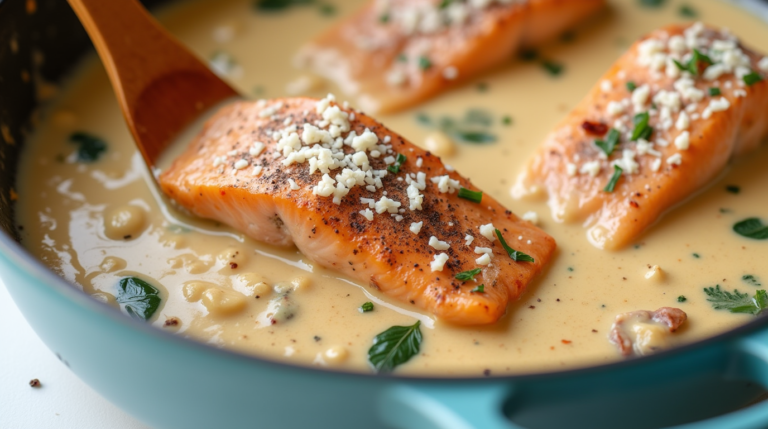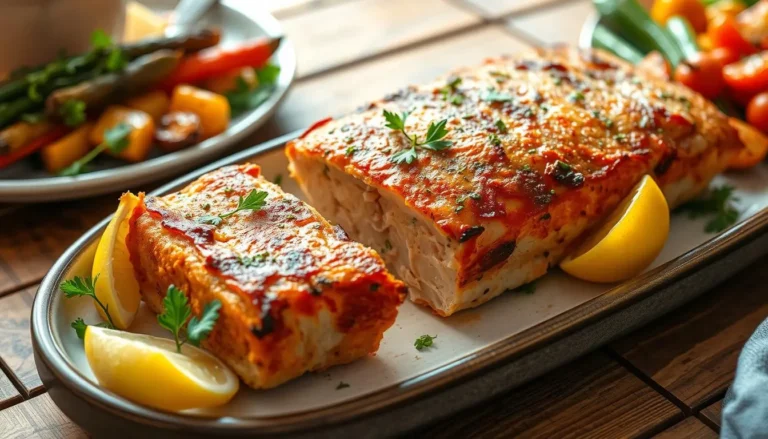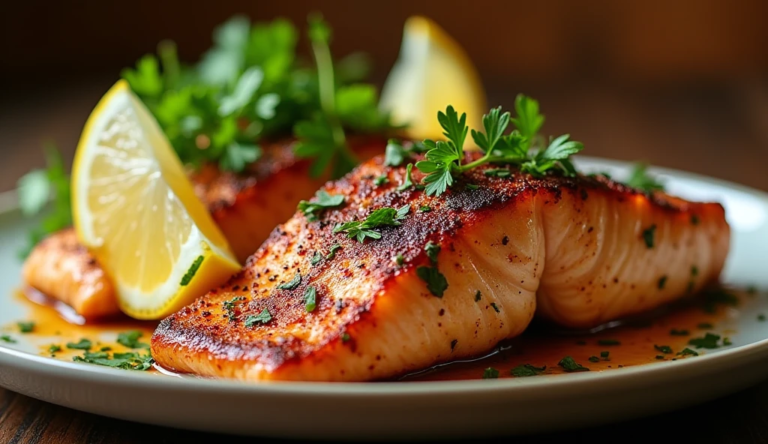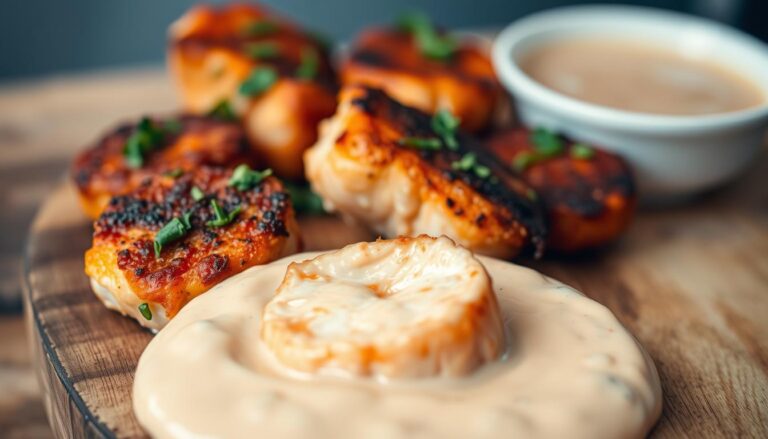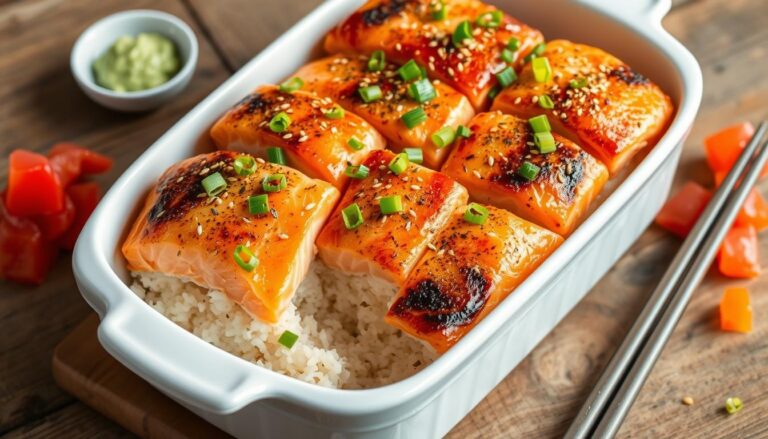here is Ideal smoked salmon internal temp for Perfect Results
smoked salmon internal temp is an art form. Mastering the ideal internal temperature is key to perfect results. Whether you’re a home chef or gourmet, this guide will help you. We’ll cover the optimal range, factors that influence it, and expert tips.
With this knowledge, you’ll create delicious smoked salmon dishes. These will impress your family and friends.
Table of Contents

What is the Ideal Smoked Salmon Internal Temp?
Smoking salmon to the right internal temperature is key for safety and taste. The perfect temperature is between 130°F and 150°F. This ensures the salmon is cooked but still juicy and smoky.
Understanding Safe Internal Temperatures
Food safety is crucial when smoked salmon internal temp. The USDA says salmon should be at least 145°F to kill bacteria. But, going over 150°F can make it dry and taste bad. The goal is to find a balance for safety and flavor.
Factors Affecting Ideal Smoked Salmon Temperature
- Salmon type: Different varieties, such as king or sockeye, may have slightly varied ideal temperatures.
- Smoking method: Hot smoking, cold smoking, and other techniques can impact the optimal internal temp.
- Smoker type: Electric, charcoal, and pellet smokers may produce different temperature results.
- Smoking duration: Longer smoking times can affect the final internal temperature of the salmon.
By understanding these factors and monitoring the internal temp closely, you can ensure your smoked salmon is cooked to perfection every time.
“The key to perfectly smoked salmon is finding the right balance between food safety and flavor.”
Preparing Your Salmon for Smoking
Smoked salmon internal temp needs the right prep for great taste. From brining to curing, each step is key. It affects the salmon’s internal temperature and flavor. Let’s look at the main steps for how to prepare salmon for smoking.
Brining the Salmon
Brining is a must for how to prepare salmon for smoking. It keeps the salmon moist and adds flavor. To make a great brine, you’ll need:
- 1 cup of salt
- 1 cup of sugar
- 2 quarts of water
- Optional herbs and spices (such as dill, black pepper, or garlic)
Mix the ingredients until the salt and sugar dissolve. Then, soak the salmon fillets in the brine. Let it sit for 2-4 hours, depending on the fillet’s thickness.
Curing the Salmon
After brining, cure the salmon. Curing makes the outside firm and dry. To cure the salmon:
- Pat the brined salmon fillets dry with paper towels.
- Sprinkle a light coating of brown sugar or cure mix over the fillets.
- Place the salmon on a wire rack and refrigerate for 4-8 hours. Wait until a tacky, dry “pellicle” forms.
This step ensures the brine for smoking salmon is absorbed. It leads to a smoky, tasty flavor.
| Brining Time | Curing Time | Resulting Texture |
|---|---|---|
| 2-4 hours | 4-8 hours | Firm, dry exterior with a moist, flavorful interior |
By following these steps, you’ll make perfect smoked salmon every time.
Choosing the Right Smoker for Salmon
Choosing the right smoker is key to perfect smoked salmon internal temp. Each smoker type, from electric to charcoal, has its own benefits. Knowing these can help you pick the best smoker for your salmon.
Types of Smokers and Their Advantages
Popular smokers for salmon include electric, propane, and charcoal. Each offers unique benefits that affect the salmon’s flavor and temperature.
- Electric Smokers are great for beginners. They keep a steady temperature, which is good for perfect salmon.
- Propane Smokers heat up fast and let you control the temperature. This is handy for keeping salmon at the right temperature.
- Charcoal Smokers give a traditional smoky taste. But, they need more attention to keep the temperature right.
The right smoker depends on your preferences and experience. Think about each smoker’s benefits to find the best one for your salmon.
Monitoring and Adjusting Smoker Temperature
Getting the perfect internal temperature for smoked salmon is key. It’s important to monitor the temperature of your smoker and adjust as needed.
Using a Reliable Thermometer
A high-quality, reliable thermometer is crucial for monitoring smoker temp for smoked salmon. It lets you track the temperature inside your smoker. This ensures your salmon cooks at the perfect temperature.
Put the thermometer probe near the salmon but not touching it. This gives you an accurate reading.
- Look for a thermometer with a wide temperature range, capable of measuring both low and high temperatures.
- Choose a digital thermometer for quick, easy-to-read temperature readings.
- Consider a wireless or remote thermometer, which allows you to monitor the temperature from a distance without opening the smoker door.
As you smoke your salmon, use the thermometer to regularly check the internal temperature. This helps you adjust the smoker temperature to keep it in the ideal range for perfectly cooked salmon.

“Consistent temperature monitoring is the key to achieving the perfect smoked salmon every time.”
By using a reliable thermometer and closely monitoring the smoker temperature, you can make any needed adjustments. This ensures your salmon reaches the optimal internal temperature for delicious results.
Brining and Curing Salmon for Smoking
Brining and curing your salmon before smoking is key. It helps get the perfect internal temperature and boosts flavor and texture. With expert techniques and recipes, you can make a smoked salmon that’s both delicious and beautiful.
How to Brine Salmon for Smoking
Brining your salmon is the first step in curing. It keeps the fish moist during smoking, making it juicier and more flavorful. Here’s how to brine your salmon:
- Create a brine solution by mixing 1/4 cup of salt for every 1 cup of water.
- Submerge the salmon fillets in the brine solution and refrigerate for 2-4 hours, depending on the thickness of the fish.
- Rinse the salmon under cold water and pat it dry with paper towels before smoking.
Curing Salmon for Smoking
Curing your salmon is another important step. It makes the fish firmer and the flavor more intense. Follow these steps to cure your salmon:
- Mix together a dry cure blend of 1 part salt, 1 part brown sugar, and 1 part dill or other desired herbs and spices.
- Coat the salmon fillets evenly with the cure mixture, making sure to cover all sides.
- Place the cured salmon in the refrigerator for 6-12 hours, turning the fillets every few hours to ensure even curing.
- Rinse the salmon under cold water and pat it dry with paper towels before smoking.
Proper brining and curing will help you achieve the perfect smoked salmon. You’ll end up with a dish that’s both delicious and visually stunning.
Wood Varieties for Smoked Salmon Flavor
Choosing the right wood for smoking salmon can change the flavor a lot. Different woods, from fruity to strong, can make your smoked salmon taste amazing. Let’s look at some popular woods and how they can make your smoked salmon internal temp taste better.
Popular Wood Choices and Their Flavors
When picking wood for smoking salmon, think about what each type can add. Each wood has its own taste that can make your salmon even better.
- Applewood: Gives a sweet, fruity taste that goes well with salmon.
- Mesquite: Has a bold, smoky flavor but can be too strong if used too much.
- Hickory: Adds a strong, bacon-like taste that suits salmon’s richness.
- Maple: Adds a subtle, sweet taste that caramelizes the salmon a bit.
- Oak: Brings a strong, earthy flavor that works well with milder woods.
For the best flavor, mix different woods. This way, you can create a flavor that complements the salmon’s natural taste.
| Wood Type | Flavor Profile | Recommended Use |
|---|---|---|
| Applewood | Sweet, slightly fruity | Pairs well with salmon, can be used as a primary or secondary wood |
| Mesquite | Bold, smoky | Use in moderation, as it can overpower more delicate fish |
| Hickory | Strong, bacon-like | Complements the richness of salmon, can be used as a primary or secondary wood |
| Maple | Subtle, slightly sweet | Adds a touch of caramelization, can be used as a secondary wood |
| Oak | Robust, earthy | Balanced with other milder woods, can be used as a primary or secondary wood |
Try different woods and blends to find the perfect flavor for your smoked salmon. The goal is to enhance the salmon’s taste without overpowering it.

“The right wood can truly elevate the flavor of your smoked salmon, transforming it into a culinary masterpiece.”
Smoked Salmon Dishes and Recipes
Mastering the perfect smoked salmon internal temperature opens up a world of delicious dishes. You can make everything from classic appetizers to hearty main courses. Let’s dive into some tasty recipe ideas to spark your next smoked salmon creation.
Smoked Salmon Appetizers
Begin your meal with a touch of luxury by making smoked salmon canapés. Place thin slices of smoked salmon on crisp crostini or blinis. Add a dollop of tangy crème fraiche and a sprinkle of fresh dill on top. For a unique twist, roll the salmon with a creamy cheese filling inside mini cucumber bites or endive leaves.
Smoked Salmon Brunch Favorites
Enhance your weekend brunch with smoked salmon. Spread cream cheese on a toasted bagel, then add smoked salmon slices and capers. For a twist, add smoked salmon to a frittata or quiche with fresh herbs and creamy cheese like goat or feta.
Smoked Salmon Pasta Dishes
Smoked salmon’s rich flavor is perfect in pasta dishes. Mix flaked smoked salmon with penne or linguine in a lemon-dill cream sauce. For a lighter dish, combine smoked salmon with spaghetti, baby spinach, olive oil, and lemon juice.
These are just a few ideas for delicious smoked salmon dishes. With your skill in achieving the perfect internal temperature, you can explore endless possibilities. Try different flavors and cooking methods to make your smoked salmon stand out in any recipe.
Troubleshooting Common Smoked Salmon Issues
Overcooked or Undercooked Salmon
Getting the perfect internal temperature for smoked salmon internal temp can be tricky. If your salmon is overcooked or undercooked, there are ways to fix it. First, make sure your smoker is set right and keeps a steady temperature.
Use a digital thermometer to check the salmon’s internal temperature. This helps you avoid common mistakes.
If your salmon is too dry, try brining it longer before smoking. This helps keep it moist. Or, cook it for less time and at a slightly lower temperature.
If it’s not cooked enough, it will look translucent. To fix this, cook it longer and at a higher temperature. Aim for an internal temperature of 145°F (63°C).
Every salmon is different, so you might need to tweak your method. With practice and attention, you’ll get great results. Soon, you’ll be a pro at smoking salmon just right.
FAQ
What is the ideal internal temperature for smoked salmon?
smoked salmon internal temp should be cooked to an internal temperature of 130°F to 150°F. This ensures it’s cooked but still juicy and full of flavor.
Why is the internal temperature important for smoked salmon?
The internal temperature is key for food safety and the best taste and texture. If it’s too hot, the salmon can dry out. If it’s too cold, it might not be safe to eat.
What factors affect the ideal smoked salmon internal temperature?
Several things can change the ideal temperature for smoked salmon internal temp . These include the salmon type, the smoker, and how you smoke it. The salmon’s thickness and how smoky you like it also matter.
How do I properly prepare salmon for smoking?
To get the best results, prepare the salmon right. Brining or curing can help. Brining keeps it moist, while curing adds flavor and texture.
What type of smoker is best for achieving the ideal smoked salmon internal temp?
The smoker type can affect the salmon’s temperature. You can use electric, charcoal, or pellet smokers to smoke salmon well.
How do I monitor and adjust the temperature in my smoker?
A digital thermometer is essential for keeping the right temperature. Check it often and adjust the smoker as needed to get the perfect salmon.
What types of wood are best for smoking salmon?
The wood you choose can change the salmon’s flavor. Alder, maple, and apple woods are popular. Each gives a different smoky taste.
What are some delicious smoked salmon dishes I can make?
Once you know how to smoke salmon, you can make many dishes. Try smoked salmon bagels, salmon cakes, or pasta. The options are endless!
How can I troubleshoot issues with overcooked or undercooked smoked salmon?
If your smoked salmon is off, try adjusting the smoker’s temperature. Keep a closer eye on the internal temperature. Also, try different preparation methods to get it just right.
Share Your Experience With us
There are no reviews yet. Be the first one to write one.


